We've all heard that most businesses fail in the first few years…
The thing is, this statistic accounts for ALL businesses…
From businesses that are started from some hair-brained idea or because the owner likes to bake/fish/collect stamps/etc. These businesses are typically doomed to fail because they're building a hobby, opposed to an actual business.
Compare that to businesses that are well thought out, planned, and follow proven business models and strategies. For obvious reasons, these businesses have a much higher success rate.
Going into 2019, my question to you is…
Do you want to build a hobby or a business?
This post is going to give you a proven system for starting a successful business in 2019 and beyond!
Step 1: Pick Your Market/Niche/Avatar
This first step is probably the most important step; however, it's often overlooked as people typically jump to Step 2.
But, here's the deal, you're going to be spending A LOT of time thinking about this topic and working with this group of people… you want to make sure it's something you like and that these are people you actually want to hang around with!
I've seen too many people try to chase the money and wind up miserable because they wind up hating the topic and/or their customer.
There Are 3 Profitable Markets
I'll be referencing Russell Brunson's book, Expert Secrets in this section.
Russell states there are 3 profitable markets:
- Health – everyone wants to be healthier, live longer, etc.
- Wealth – everyone wants enough money to be secure, some people want more than that.
- Relationships – everyone wants to have great relationships; marriage, love, friends, etc.
These 3 markets have dozens of sub-markets:
- Health – diet, nutrition, strength training, weight loss, etc.
- Wealth – business, investing, real estate, sales, etc.
- Relationships – love, dating advice, marriage, parenting, etc.
Then, if you go another level deeper, you have niches… and, this is what you want to figure out.
- Health –> Nutrition –> High Fat Diets
- Health –> Weight Loss –> Weight Loss For College Students
- Wealth –> Real Estate –> Flipping Houses On eBay
- Wealth –> Online Business –> Facebook Traffic For eCommerce Stores
- Relationships –> Parenting –> Dealing With Teenagers
- Relationships –> Dating –> How To Recover After A Breakup
Got a niche?
Cool, now let's figure out who your customers are!
Construct Your Customer Avatar
Your objective is to answer all of the questions below. Doing so will help with targeting your audience and with your messaging.
Some of these questions are pulled from the Customer Avatar Worksheet available from DigitalMarketer.com.
Demographics
- Name
- Age
- Gender
- Marital Status
- #/Ages Of Children
- Location
- Occupation
- Job Title
- Annual Income
- Level Of Education
Interests
- Celebrities/Gurus
- Causes
- Organizations
- Websites
- Apps
- TV Shows
- Clothing
- Musicians
- Books
- Magazines
- Movies
The 3 Whys
Go through the Demographics and Interests you came up with, asking “why” three times to uncover the individual's psyche.
Once you understand their psyche, you'll be better able to answer these questions as they pertain to your market/niche/business:
- Goals and Values
- Challenges and Pain Points
- Objections and Roles
How To Create Your Customer Avatar Quickly With Facebook's Audience Insights Tool
- Audience Insights Tool
- Avatar Sheet, Blank (file, make a copy)
- Avatar Sheet, Filled Out Example
- Expert Secrets Book
- Digital Marketer's Avatar Worksheet
Step 2: Figure Out What To Sell Them
Hopefully you've completed Step 1 and have a Niche and a Customer Avatar. If not, go do that first!
Now that you have your customer and you know their goals and values, challenges and pain points, and objections and roles… it's time to figure out how to help them!
Help them?
Yes! What you sell to people should help them… otherwise, why would they buy it?
So, with your helpful and caring mindset, it's time to go looking for products and services to sell.
But, where do you start?
5 Types Of Products You Can Start Selling Online TODAY!
Alternatively, if you don't want to watch another video, you can check out this blog post here.
To recap the video and blog post, here are the 5 types of products:
- Dropshipping
- Print on Demand
- PLR/MRR
- Productized Services
- Sell Other Businesses' Products
Finally, you don't have to use one of aforementioned product types if you don't want to. If you want to create something from scratch or you already have products you want to sell – that's great, do that!
This list is simply for those that are stuck and don't know what to do.
Come Up With 3-5 Things To Sell
Your goal now is to come up with 3-5 products or services to sell.
JUST 3-5!
Yes, you can probably find thousands of options, but we want to get some momentum first. You can always expand your product line later.
If you try too many products at once, you'll spread yourself too thin and nothing will work out for you…
And, believe it or not, customers don't want a million options either…
Ever been to a restaurant that has a million items on the menu? How long did it take you or your significant other to make a decision? I bet one of you took “forever”!
Start simple. Give your products/services a fair shot. Adjust from there.
Uncover The Features & Benefits Of Your Product/Service
You've probably hard the saying, “people don't want a drill, they want a hole.”
You can take it a step further, “people don't want holes, they want to hang their shelves.”
And, further… “people don't want shelves, they want a place to store their extra stuff.”
(the 3 why's ringing any bells here?!)
The point is, people aren't buying a product/service… they're buying the result.
You need to take the 3-5 products/services you've come up with and merge the result they produce with the goals and values, challenges and pain points, and objections and roles your customers are facing.
An easy way to merge all of this is with feature/benefit bullet points.
Which feature of your product/service helps with…
- The goal(s) they're trying to accomplish
- The value(s) they hold dear
- The challenge(s) they're facing
- The pain(s) they're feeling
- The objection(s) they have
- The role(s) they play
What you may find, after doing this, is that the product/service you're selling is underwhelming.
Or, maybe there are too many objections or you're not directly addressing the decision maker.
This happens, and it's OK.
Everything you sell isn't going to change someone's life…
But, everything you sell can (and should) be of great perceived value!
“Offeratize” Your Products And Services
Your products and services are NOT offers…
While an offer includes a product/service and its features, benefits, and advantages… it also includes all the other bells and whistles:
- Bonuses (HUGE!)
- This is how you increase the perceived value of your regular ol' product!
- Money Back Guarantees
- Pricing Terms (payment plans)
- Risk Reversal (how are you going to ensure they don’t waste time, money, etc. this includes your money back guarantee)
I recommend listening to Todd Brown’s “The Marketer’s Mind” episode 20 for this, click here for it.
Also, take a look at what your competition is offering. Are they selling products and services or are they selling offers? How can you offer more?!
The point is, you can take your underwhelming product/service that's facing too many objections and “soup it up” to make it irresistible!
An Example
Let's take Josh from our avatar example discussed in the video above – 35 year old male, interested in Keto Diets, in the military, etc.
After asking the 3 why questions, we know he's interested in enhancing his performance, in order to perform his job well. He's willing to workout hard, eat right, and even take supplements. (note: we've uncovered 3 categories of products we can sell our avatar: exercise stuff, nutrition stuff, and supplement stuff)
We decide to work with a white label supplement manufacturer to produce a performance enhancing supplement…
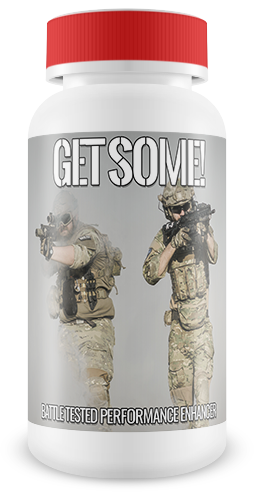
Pretty cool looking container, right?!
Of course, I'm being sarcastic… it's a lame looking container, but you get the idea. It's a performance enhancing supplement designed specifically for our customer avatar!
Now, let's extract the features and benefits of our product by comparing it to…
- Goals: Optimal performance on the job
- Get Some! has a sustained release, ensuring you're performing your best all day without any ups, downs, or crashes!
- Values: Eating healthy foods, ketosis
- Get Some! contains 100% organic ingredients and is the only FDA approved performance enhancer on the market!
- Get Some! contains no sugars or fillers that hinder ketosis!
- Challenges: Works a lot, limited time, sometimes has to eat MREs (unhealthy Army food)
- You'll feel the power of Get Some! within 5 minutes of ingestion! Our fast action formula makes sure you feel good when you need it most!
- Get Some! contains Exogenous Ketones which have been proven to offset the negative effects of sugar and other high carb foods!
- Pains: Worried about being off his game when it's time to make hard, on-the-job decisions
- After 2 years and 10,000 scientific tests, Get Some! is proven 100% effective for maximizing the decision making part of the brain! (lateral frontal cortex)
- Doctors and scientist everywhere are calling it “The Limitless Pill” because it unlocks your whole brain!
- Objections: Has tried performance enhancing supplements before, they don't work
- Get Some! contains a brand new, proprietary blend of ingredients never before released on the market, until today!
- Roles: Key decision maker
- Take control of your performance with Get Some!
We now have some features and benefit bullets for our product that align with our Customer Avatar.
Now, it's time to offeratize our product!
- Bonuses
- Waterproof pill container so they are with you on the go
- Mobile app with 5 minute puzzles that activate certain parts of your brain so you can prepare for what's ahead
- 31 day workout program for increasing day-to-day performance (PDF and Video)
- 31 quick recipes for increasing day-to-day performance (PDF and Video)
- Money Back Guarantee
- If you don't feel a significant difference in your performance within 30 days, you let us know and we'll refund your payment AND give you a $100 Amazon Gift Card for wasting your time!
- Pricing Terms (payment plans)
- Free Shipping on all orders
- Buy 2, save 10%
- Buy 3, save 20%
Step 3: Build Micro Sales Funnels To Sell Your Offers
You should have a couple offers created for your customer avatar.
Now you need a way to display your offer and collect money from your customer.
The best way to do this is with a Micro Sales Funnel.
What is a Micro Sales Funnel?
It's a collection of web pages, engagements (email, text messages, phone calls, etc.), and retargeting ads that act like a digital sales rep that works for you 24/7/365!
Think about ordering food at McDonalds. You order a burger, then the cashier asks, “Would you like fries with that?” Then, they offer a drink, the chance to Super Size it, etc. Instead of spending $4, you've spent $14. That's a Micro Sales Funnel.
Here's an example:
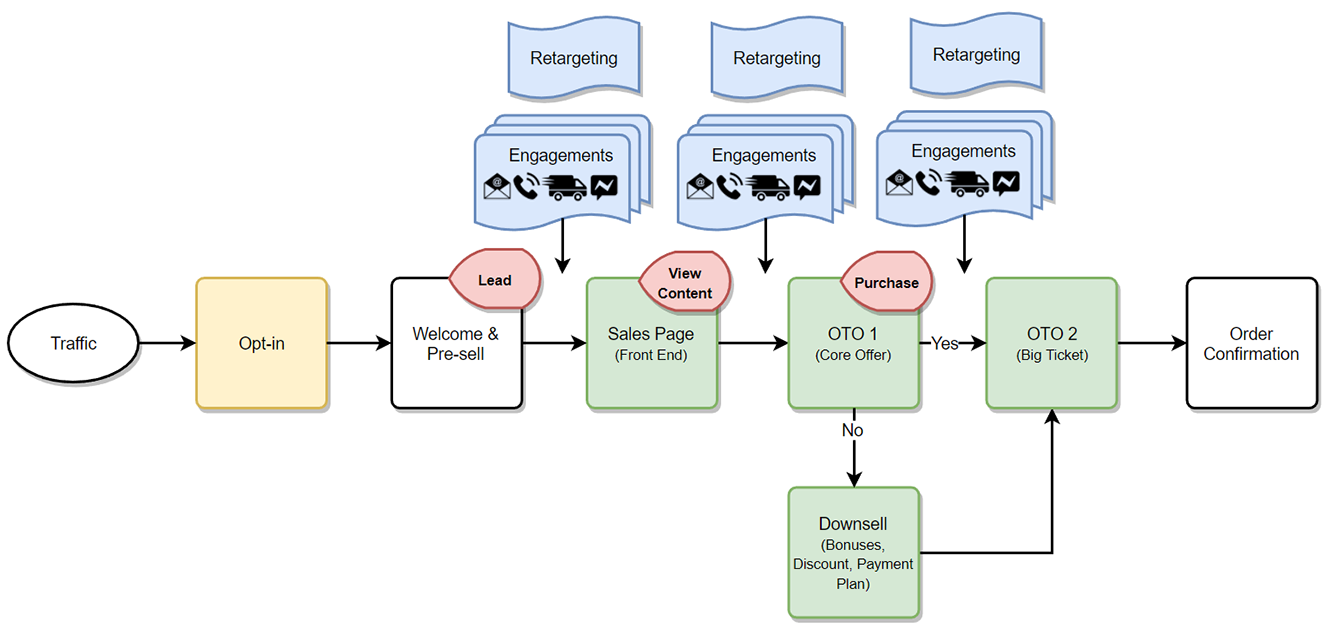
Micro Sales Funnels come in all shapes and sizes, depending on what you're trying to sell and who you're trying to sell it to. If you'd like to learn more about the various models, I recommend checking out this post: What Kind Of Sales Funnel Should I Build?
The example funnel above is what I call a “Classic” Micro Sales Funnel. Here's a breakdown of the funnel:
- Opt-in: An individual enters their contact information in exchange for a Lead Magnet. A Lead Magnet is simply a freebie offer someone wants, like a coupon, checklist, video training, trial, etc.
- Welcome & Pre-sell: After the individual has given you their contact information, they land on a Welcome & Pre-sell page that tells them the Lead Magnet they requested is on its way and while they wait, here's some info about our company and how we can best serve them!
- Sales Page: This is the page that's selling one of your offers.
- OTO #: Stands for One-Time-Offer. These are typically 1-click upsell offers, where the individual can add additional offers to their order with 1-click.
- Downsell: These are pages shown to individuals that turn down the OTO. Usually, you try to sell your OTO again; however, this time you incentivize it by including some bonuses, a discount, or payment plan.
- Order Confirmation: This is the final page of the Micro Sales Funnel that confirms the individuals order and may also link to other, complementary offer funnels.
- Engagements: These are emails, text messages, Facebook Messages, ringless voicemails, phone calls, direct mail, etc. that is typically automated and designed to help pull your customers through your funnel.
- Retargeting Ads: These are advertisements that follow individuals around the web, advertising your business and offers again and again, in an effort to drive more sales.
All of the pages, engagements, and ads are specifically designed to help you sell your offers.
You're not simply building a random website with some products on it and hoping someone buys something.
Everything you do with a funnel needs to be calculated and methodical.
Of course, it's going to take you some time to understand how these things work. It's going to take time to understand psychology and marketing…
But, it's all worth it because as Russell Brunson, founder of ClickFunnels, always says, “You're only one funnel away!”
Your goal: Build a Micro Sales Funnel for every. single. offer.
Watch Me Build A Micro Sales Funnel Quickly
Step 4: Connect Your Micro Sales Funnels With Marketing Automation
Let's recap everything you should have right now:
- Your niche and a customer avatar
- 3-5 different offers
- 3-5 Micro Sales Funnels (1 for each offer)
For step 4, you want to connect all of your Micros Sales Funnels with marketing automation.
What's marketing automation?
Emails, text messages, ringless voicemail, direct mail, Facebook Messenger… any type of communication and engagement that can be automated, leaving you with something that looks like this…
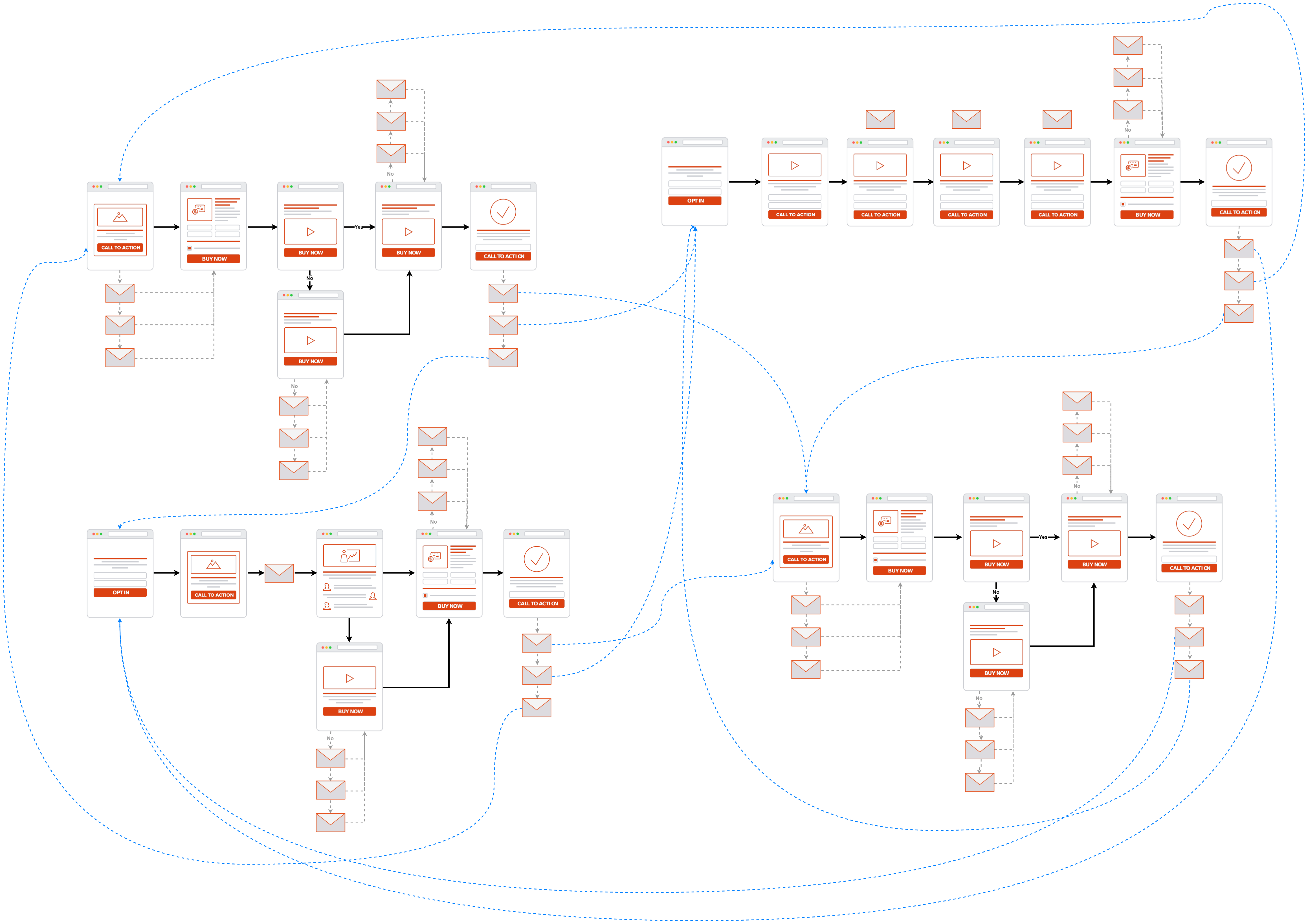
Pretty cool, right?
Note: Even though the diagram above only shows emails, you can use other mediums like text messages, Facebook Messenger, ringless voicemail, direct mail, and more to connect your Micro Sales Funnels together.
What Do You Send To People?
We could spend months, if not years discussing this topic, so I'm going to keep it pretty high level for this post.
Your audience and customers go through a journey, right?
The “Customer Journey”:
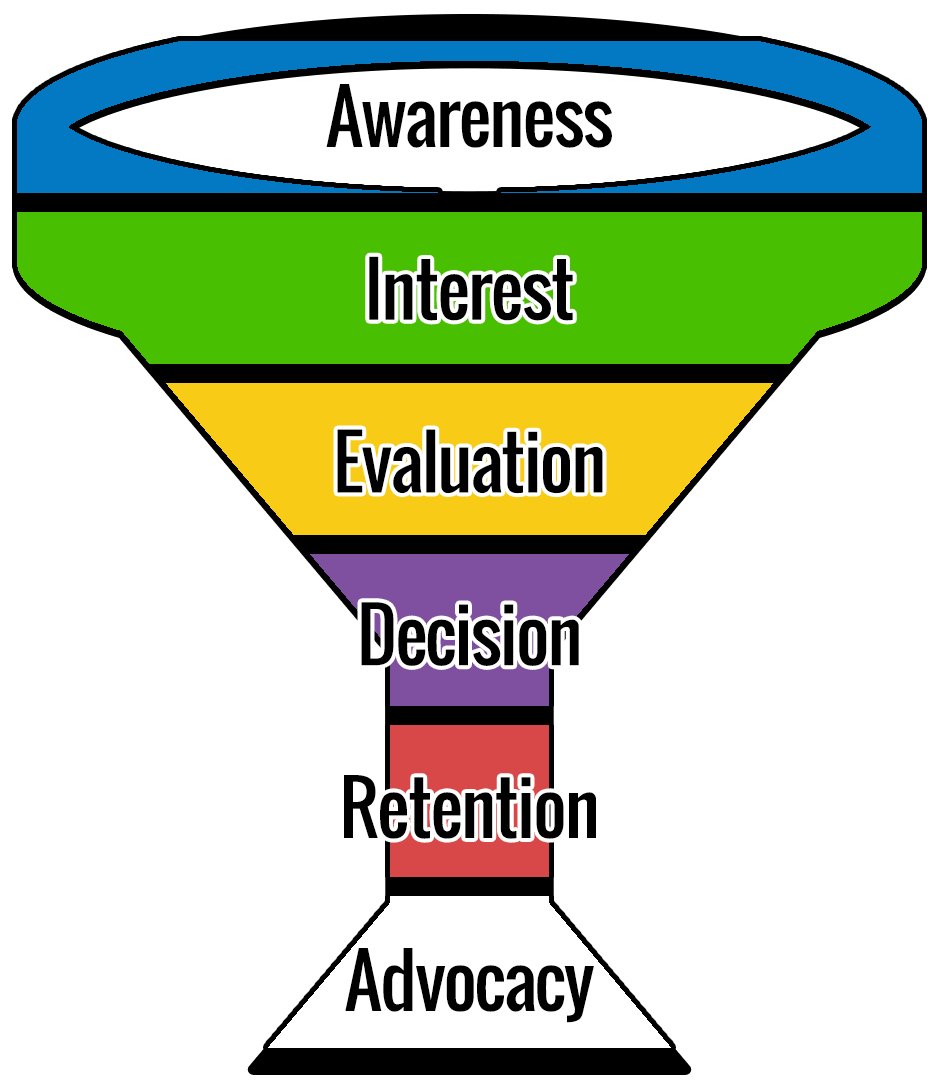
- Awareness: of pain, of need, of solution, of your business
- Interest: they start conducting research
- Evaluation: they’re going to buy something, but they want to make sure they get the “best” one
- Decision: they buy
- Retention: keep them happy, sell more
- Advocacy: they tell everyone about your business
Depending on where they are in this journey will dictate the type of content you send them.
With that said, there's two types of content you will need to send to people:
- Relationship Content
- Action Content
Relationship Content
Relationship content, you guessed it… builds a relationship!
It's content that's educational and/or entertaining. Content people enjoy consuming.
This can include helpful how-to tutorials, funny stories, deep data analysis, back & forth communication, and so on.
You're also using this content to gauge your audience members' interests… what topics are they clicking on and viewing?
Are they interested in Keto recipes? Keto supps? Lifting heavy weights? All of the above?
While you're building a relationship, you're figuring out what the person is interested in so when it's time to sell them something, you can recommend a product or service they're most likely to actually buy!
Action Content
Action content drives the person to take action, ie. buy something, come visit your store, give you a call, etc.
You've spent time building a relationship while simultaneously figuring out their interests…
Now, it's time to recommend a product or service to them!
One of the simplest action pieces you can deliver to someone is one that highlights a sale or special promotion: “1 day only, get 30% off our Get Some! supplement… click here!”
Simple enough, right?!
Of course, you can get fancier by using copywriting formulas like the Problem-Agitate-Solve formula, or the Before-After-Bridge formula… but, typically, what I've found is that if you've spent the time establishing the relationship FIRST and then place a really attractive offer in front of them… you don't need to try and mind-hack them or anything!
You can be a normal person (a friend or trusted adviser) recommending a product/service to another normal person!
This is why it's critically important to take the time to understand your audience's needs, wants, and desires AND to craft super-awesome-amazing offers! It saves you so much time later on.
Watch Me Integrate My Micro Sales Funnel With Marketing Automation
Step 5: Fill Your Sales Funnel With Traffic
By now, you should have…
- Your audience/niche figured out. You know where they hangout and you're ready to approach them!
- Your irresistible offers developed for your audience members.
- A few Micro Sales Funnels setup to actually sell your irresistible offers.
- Those Micro Sales Funnels interconnected with Marketing Automation that builds a relationship, gauges interests, and then promotes your irresistible offers.
Got all that?
Great! Now, lets fill your system up!
Introducing “The Triple Threat Strategy”
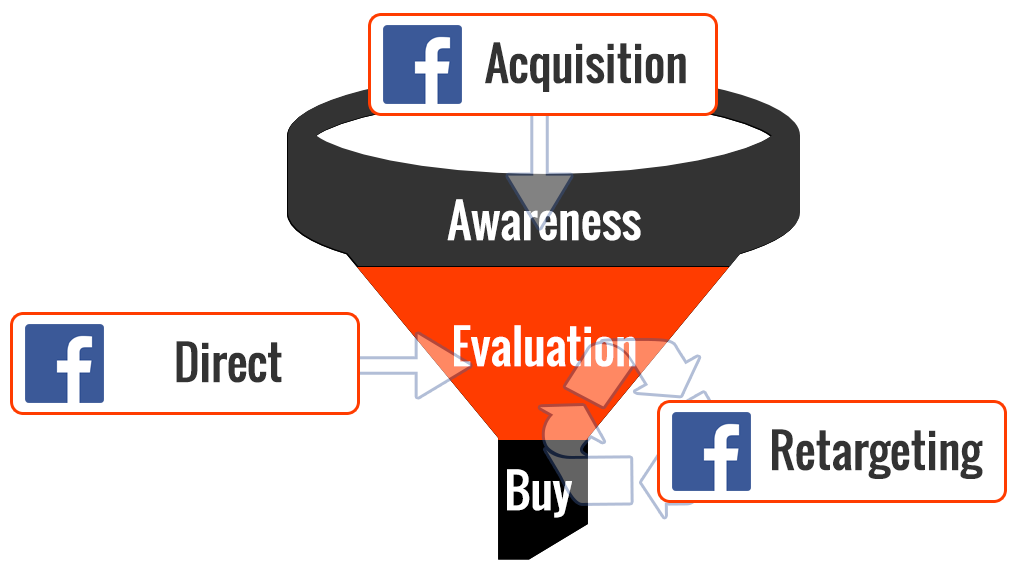
The Triple Threat Strategy is comprised of three parts:
- Acquisition: Convert cold traffic (people that don't know about you or your business) into warm traffic (people that know about you and/or your business)
- Direct: Convert cold traffic into hot traffic (leads and buyers)
- Retarget: Convert warm traffic into hot traffic
Also, notice how it's a funnel a giant funnel, just like the Customer Journey funnel displayed above… same exact concept here!
Acquisition Campaign
The main goal of the Acquisition Campaign is to convert cold traffic into warm traffic. (ie. grow your Custom Audiences [retargeting audiences])
This is accomplished by producing great pieces of content that connect with your prospects and helps them establish rapport with your business.
You want the prospect to know, like, and trust you at this stage.
Here are a couple Acquisition Ad examples…
This first one is a video. Videos work great as acquisition ads because you can build Custom Audiences (used for retargeting later) based upon how much of a video an individual watches. For example, 3 seconds, 10 seconds, 25%, 50%, etc.
It's typically a lot easier to get someone to watch 10 seconds to 25% of a video on Facebook than it is to get them to click away from Facebook to visit your site. Thus, you're able to grow your Custom Audiences for pennies on the dollar!
The second ad is an image ad that links to a high quality blog post…
Those are examples of Acquisition Ads.
As you can see, they're pure content and goodwill. Nothing for sale (at least not directly) in either of them!
Direct Campaign
There are two goals for the Direct Campaigns:
- Convert cold traffic directly into a lead or customer. Sometimes this works, sometimes it doesn't… but, it's usually worth giving it a shot.
- Convert cold traffic into warm traffic. Introduce your business and what you have to offer.
Here are a couple Direct Ad examples…
This first one is a “direct to offer” ad where I'm trying to convince cold traffic to claim a “free” dog training clicker.
The tactic behind this ad is to make the offer soooo good, it's impossible to refuse. Basically, I'm looking for impulse buys…
The second Direct Ad brings people to an opt-in page where they can request my Lead Magnet: 100 Dog Training Tips.
The purpose is to convert cold traffic into leads that I can follow up later with email and retargeting.
Those are a couple Direct Ad examples.
As you can see, they bring people directly from Facebook to an offer… whether it's for a product or a just a lead magnet.
Retargeting Campaign
The main goal of the Retargeting Campaign is to take your warm traffic and convert them into leads, customers, and repeat buyers.
By this time, you will have warm audiences either from people engaging with your Acquisition or Direct Ads…
They know about your business and what you offer…
It's now time to promote offers to convert individuals into leads, customers, and repeat buyers!
Here's an example Retargeting Ad…
Since Retargeting Ads are used on warm audiences, you can make “bigger” offers. Basically, you don't have to try and sell some cheap product in order to attract impulse buyers.
Often, you'll lose money on the Direct Ads, but make up for it 10 fold during the retargeting phase!
How To Execute The Triple Threat Strategy
We've uncovered the Triple Threat Strategy and the 3 core campaigns…
But, how do you actually execute it?
How do you know when an ad is working? How do you know when it's not?
Don't worry, I have a flowchart to answer all of these questions and more!
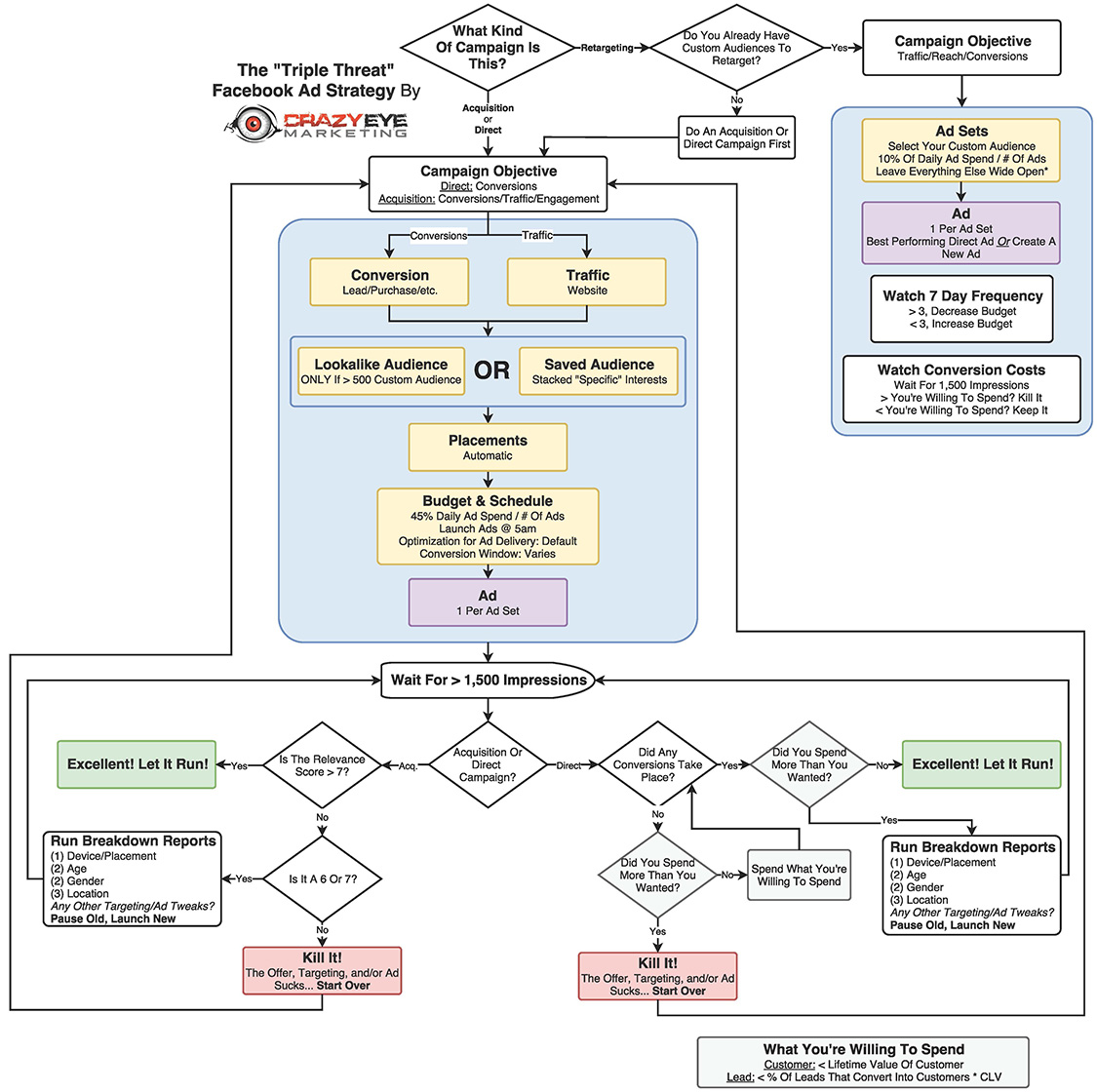
Yup, she's a doozy!
Now, I'm not going to explain this whole thing right now since it would take hours…
But, hopefully it gives you some perspective of how that funnel diagram translates into real life actions you can take to execute the strategy!
Here's How To Launch A Facebook Ad
Links Mentioned:
- FB Pixel on WordPress
- FB Pixel on ClickFunnels
- FB Pixel on Kartra
- Facebook Ad Copy 101
- Facebook Campaign Objectives
Are You Ready To Make 2019 YOUR Year?!
This post has outlined an ENTIRE game plan for you from start to finish!
You now know what you have to do…
- Identify your audience/niche
- Develop your offers
- Build Micro Sales Funnels to sell your offers
- Connect your Micro Sales Funnels with Marketing Automation
- Fill your entire sales system with traffic
This is your chance to start that side hustle to get some extra cash flow or to even replace your 9-5!
People are making money every day with sales funnels, marketing automation, and traffic generation… why shouldn't you be able to make it work?
2 Reasons These 5 Steps Won't Work For You
- You don't actually do anything with them. You keep doing what you're doing.
- You do them halfway. Maybe you get overwhelmed by the technical stuff, so you quit. Or maybe you bounce over to some shiny object. Whatever the reason, you do things half-assed (excuse my french!)
The point is, if you do everything outlined in this post…
You avoid excuses…
And, you put in the time to make it happen…
I guarantee you'll be successful!
Finally…
I have a full blown training program that teaches you the nitty-gritty details of EVERYTHING outlined in this post.
